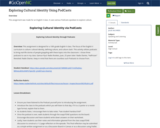
This assignment was made for an English II class. It uses various PodCasts epsidoes to explore culture.
- Subject:
- Speaking and Listening
- Material Type:
- Activity/Lab
- Author:
- JULIE SALYARDS
- Date Added:
- 06/15/2021

This assignment was made for an English II class. It uses various PodCasts epsidoes to explore culture.
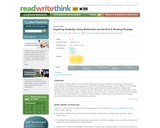
This resource provides a lesson wherein students will seek to apply the B-D-A (before-during-after) reading comprehension strategy while they examine resources pertaining to disabilities.
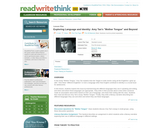
This lesson will help students identify the various uses of language and understand their appropriateness within context. Students participate in journal writing as well as writing literacy narratives describing multiple uses of language. The lesson is designed to accompany a ready of "Mother Tongue"; however, the lesson may be used in conjunction with a study of other writings in English by authors who write or speak English as a second language.

This resource provides a lesson designed to assist students with identifying the skills they use to read and comprehend with a small group. Afterwards, learners with use some of those strategies to read online, informational texts. As a culminating activty, students will report their discoveries through discussion pertaining to the differences in reading physical and online texts and the strategies they used.
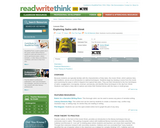
This resource provides a lesson designed to help students understand the use of satire and the myriad technicques that authors may use to add it to their writing. Students use the film Shrek to examine the four techniques of exaggeration, incongruity, reversal and parody. Students prove their understanding by using satire to rewrite a fairly tale.

This lesson is designed to accompany a reading of a text that has a film version. Students will create visions of a given text and compare them to the film version.

GIST is a strategy to help students write brief, accurate, and complete summaries of material they read. In this lesson, students work together summarizing larger and larger portions of text, keeping their summaries at 25 words or fewer.
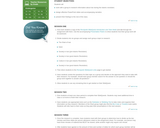
The graphic novel Persepolis is set in Iran during the Islamic Revolution. Most students are unaware of the changes associated with the events during that time, but the repercussions of the revolution are still being felt throughout the world. In this lesson, students work in small groups to research a specific topic related to Iran, using a WebQuest to focus their research on relevant and reliable information. After the research is complete, students present their information to the class through a technology-enhanced presentation.

Students will read, critically analyze and write about a series of poems dealing with ghosts and spirits.
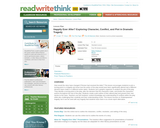
This lesson encourages students to pick a turning point in Shakespeare's Romeo and Juliet and show how the action of the play would have been significantly altered had a different decision been made or a different action taken. Students will use a graphic organizer to analyze the plot of the play, create a plot outline of an altered play, and present their new stories to the class.

In this multi-day unit students conduct research, work with an interactive Venn diagram tool, and create a museum exhibit that highlights the work of selected artists, musicians, and poets. Critical thinking, creativity, and interdisciplinary connections are emphasized.

This resource provides a lesson designed to assist learners with acquiring skills needed to differentiate between real and fictious, possibly malicious, websites. Students will evaluate hoax sites prior to outlining and designing one of their own. It is expected that this lesson will help students to better recognize trustworthy sites for online reading and research.
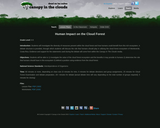
Students will investigate the diversity of resources present within the cloud forest and how humans could benefit from this rich ecosystem. A debate structure is provided, through which students will discuss the role that humans should play in utilizing the cloud forest ecosystem of Monteverde, Costa Rica.

Students begin by evaluating the universal theme of betrayal from multiple perspectives. After reading time period scenarios as well as reflecting on personal experiences, students use critical thinking skills to explore and identify interventions for each betrayal scenario, including personal examples. Students then research Roman history as they write down thier own critical perspective of a scenario depicting plausible scenes from Roman times. As the culminating project and assessment, students will create comic strips with the Interactive Comic Creator
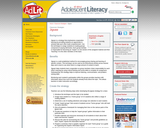
Jigsaw is a strategy that emphasizes cooperative learning by providing students an opportunity to actively help each other build comprehension. Use this technique to assign students to reading groups composed of varying skill levels. Each group member is responsible for becoming an "expert" on one section of the assigned material and then "teaching" it to the other members of the team.
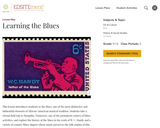
This lesson introduces students to the blues, one of the most distinctive and influential elements of African-American musical tradition. Students take a virtual tour of Memphis, TN and explore the history of the blues in the work of W.C. Handy and a variety of country blues singers whose music preserves the folk origins of this unique American art form. The lesson concludes with students composing their own blues lyrics.

After students have read a book about the Holocaust, such as The Diary of Anne Frank or Night by Elie Wiesel, students will view Life is Beautiful and complete discussion questions that challenge their ability to analyze literature using film. When the film is complete, students will write a letter to the director conveying their opinion of the film.

Students will read, critically analyze and write about a series of poems dealing with light and darkness.

This lesson encourages students to justify their thoughts about literature by prompting them with ambiguous test questions. Students take the test without understanding that questions are intentionally unclear, then justify their answers with textual citations for credit.

This lesson revisits the original nine African-American children who broke the color barrier at Central High School in Little Rock, Arkansas in 1954. Lessons include close reading and analysis of news reports, television news accounts and writing assignments.